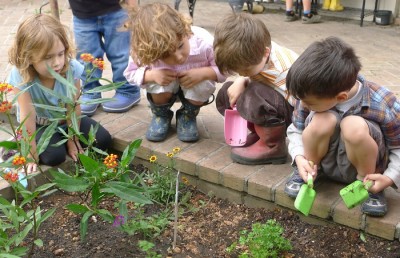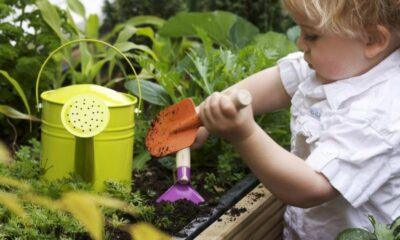
Image source: gardeningtoolsplus.com
Gardening is fun and it’s all the more so if you involve your kids. People often recollect the time they spent gardening with a parent or grandparent with much fondness. Francis Bacon called it “the purest of human pleasures.” Anyone who grew up nurturing a plant or two likely would agree. Gardening can be a lifelong hobby and an effective stress-buster. Give your kids this gift and it will stay with them forever. Here are a few more reasons to grow a garden with your children:
1. Enjoy meaningful family time
In our fast-paced lives, it’s essential to set aside some time for informal family gatherings. Parents and children getting together for shared activities leads to bonding and opens up communication channels. In most households, however, family time has been reduced to a hurried dinner or watching a movie or football game together. Something is better than nothing, of course, but growing a garden with children will provide a meaningful activity for the whole family. It’s quality time at the very best. Plan a bulb-planting day, a seed-starter weekend or a photo shoot in the garden to get everyone involved.
2. Get children to eat more vegetables
Children are famously reluctant to eat vegetables, especially the green stuff. The more we emphasize the health benefits of vegetables, the less they seem to appeal to them. Maybe the problem lies with our constant goading to “eat up the greens.” To combat this resistance and spare everyone the nagging, have them plant some edible things in your garden. You’ll be surprised at their enthusiasm to eat peas and snap beans straight off the plants. Add a variety of salad greens and different types of root vegetables, too. Once they are hooked, you’ll never need to harp on the goodness of vegetables again.
3. Reconnect with nature
We talk a lot about environmental pollution and sustainable living, but there is no better way than gardening to get children connected to the natural world. Today’s generation is so disconnected from nature that they hardly know where our food comes from or from what our clothes are made. The bookish knowledge often fails to translate into real understanding of how our needs are met. Give them a chance to dig in the mud and observe the interaction between living things and the elements. Establishing a personal relationship with the environment makes them naturally protective of it.
4. Help reduce waste
The tremendous amount of waste we generate in our modern lifestyle is one of the greatest threats to the environment. Statistics about the number of trees felled each year to make paper will have no real meaning for a child unless he or she tries to grow a tree.
Order your 2015 Heirloom Solutions seed catalog and get $20 in your account!
Help your child grow a peanut plant. Then dig up the nuts and show how much peanut butter can be made from them. While a child observes honey bees collecting nectar from the flowers, point out that a single bee makes less than a teaspoon of honey in its entire lifetime. A healthy respect for the producers naturally makes us thrifty.
5. Learn cause and effect

Image source: flowerpower.com.au
When you involve children in gardening you can spare that lecture on cause-and-effect. The results of action (or inaction) are right before them. When a wilting plant bounces back after a watering, some fertilizer brings out luxurious growth, or weeds take over the garden after a few days of neglect, they see the impact outside forces have on nature. Where else can you learn life’s little lessons with such ease?
6. Develop problem-solving skills in children
You cannot expect to have a life without problems. Our success and failure greatly depends on how we solve the problems that arise. Children pick up this life skill when they see their parents fixing everyday problems. Repairing a broken appliance or a leaking faucet can be tangible examples, but they may require some technical know-how.
On the other hand, staking a top-heavy flower head or guiding a trailing pea plant onto a support does not take much effort or knowledge. You could discuss the options and encourage them to share their own suggestions. When children watch and learn such simple solutions to recurrent problems, they become self-sufficient surprisingly quickly.
7. Nurture creativity
Growing things from scratch is the closest children can come to the creative process. Watching a seed sprout and put out leaves, a tightly closed bud slowly blossoming into a pretty flower, the beautiful blend of colors nature uses to dress herself; all these cannot fail to touch even the most insensitive psyche.
New Natural Fertilizer Doubles Garden Production!
Besides that, the garden offers many opportunities to exercise your creativity. Show your child the basics of planting a garden and provide a piece of land for experimenting. It is a free canvas that can be worked and reworked over and over again. “My garden is my most beautiful masterpiece,” claims Claude Monet, the father of Impressionist painting.
8. Enhance the learning skills of children
We’re not talking about just biological sciences here. Don’t we often complain about the short attention span of children? But a line of ants or a slug laboriously moving across the yard or a caterpillar munching on the tender leaves may hold the attention of a child much longer than you expect. Children have a natural curiosity and fascination for the natural world and there has been no better teacher than nature.
9. Teach about the cycle of life
If you’ve ever tried explaining the meaning of life and death to young children, you know how hard it is. They cannot grasp these abstract concepts in relation to their own lives. But a garden is teeming with life that’s constantly growing, withering, dying and regenerating.
The seeds die off in order to make a new plant, a tiny fruit appears as the apple blossom loses its pretty petals, and leaves fall down and turn into plant feed. The life cycle of butterflies, ladybugs and frogs also come under the scanner. The seasons bring their own changes to the garden. When children observe these transformations, the transient nature of life doesn’t need any explanation.
So what are you waiting for? Gather your children and go plant a garden.
What reasons would you add to the list? Do you have special gardening memories as a child? Share them in the section below:
You Can Grow A Garden With Kids No Matter Where You Live. Read More Here.
 Off The Grid News Better Ideas For Off The Grid Living
Off The Grid News Better Ideas For Off The Grid Living




